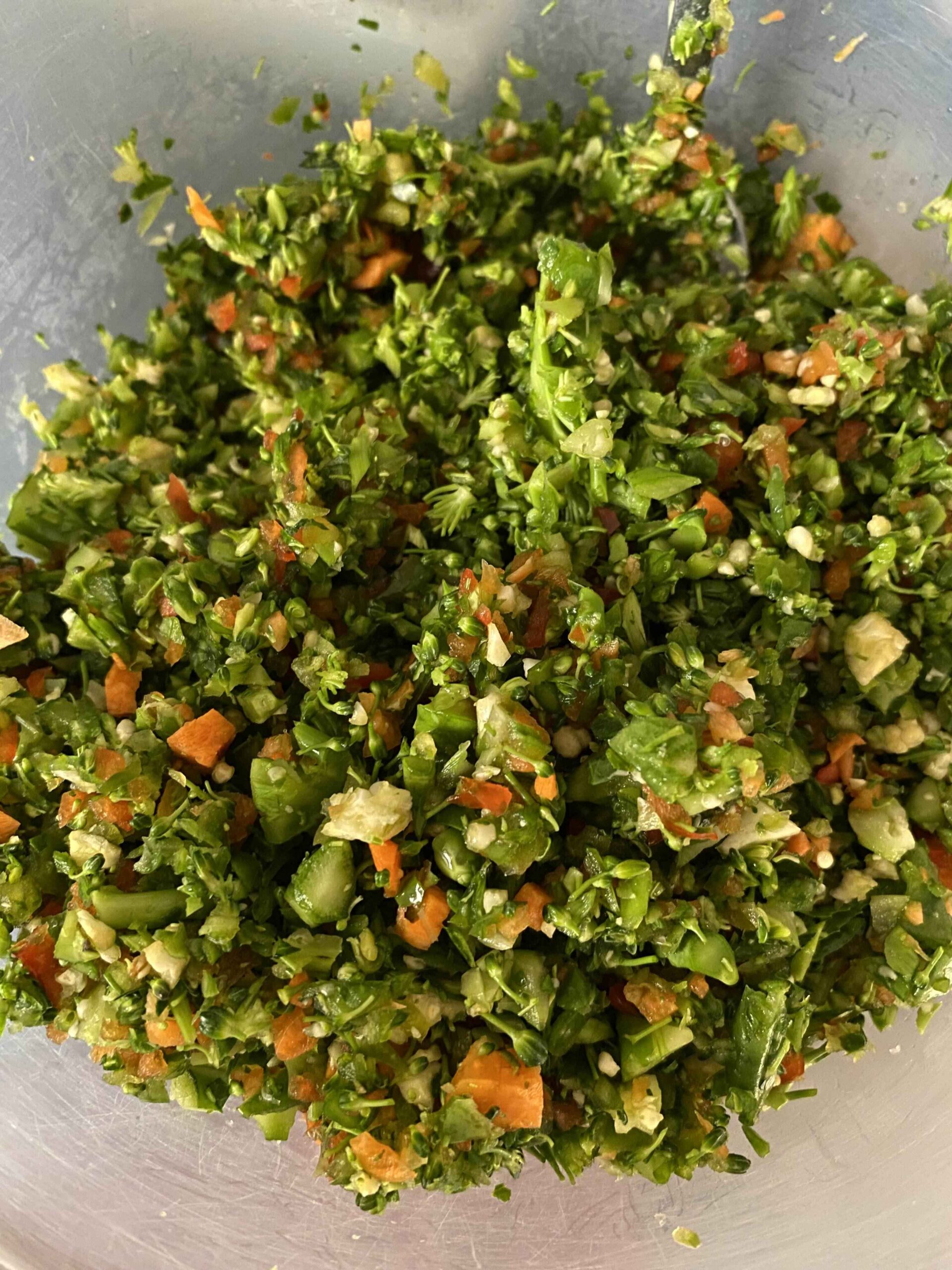



Introduction
Parrot diets can vary between species, however; most non-nectar eating parrots have a similar diet. While in the wild, they feed on a variety of foods including vegetation, flowers, fruits, grains, insects, and legumes. In captivity, the basis of a parrot’s diet is a mix of chop and pellets.
Table of Contents
Parrot Chop
A chop is a mix of chopped nutritious vegetables, legumes, grains, and a small amount of fruits or flowers. You can make chop fresh every morning, every few days, or in large batches and frozen. You can freeze chop for 2-3 months in an air-tight container. Using the vegetables you already eat as well as safe, untreated plants from outside is a great way to save money while still providing adequate nutrition for your parrot. Because your bird may show different preferences for vegetables and textures you may have to experiment to find a chop recipe that works for you and your bird.
Sample Chop Recipe
When making a chop recipe start with a base that looks something like this;
- One or two red and orange vegetables
- Red and orange vegetables are rich in vitamin A, vitamin C, and potassium. They are also an excellent source of beta carotene, which is processed into vitamin A.
- Dark leafy green vegetable
- Dark leafy greens are essential in any chop recipe, as they provide vitamin A, vitamin C, vitamin K, and calcium. Avian veterinarians and nutritionists recommend including a variety such as kale, Swiss chard, turnip greens, collard greens, mustard greens, dandelion greens, and broccoli. While most greens can be served raw, romaine and spinach should be used in moderation as they and some other greens contain oxalic acid, which can interfere with nutrient absorption. However, boiling helps break down oxalic acid, reducing its impact, and a nutrient-rich diet can further offset this effect.
- Two to five other vegetables
- Other vegetables add variety and nutritive value to your chop. An easy way to add extra vegetables is through a frozen vegetable mix of carrots, corn, peas, and green beans.
- One or two forms of legumes
- Legumes are useful in chop because they add a healthy source of protein while also being low in fat, In addition they are a excellent source of iron, folate, potassium, phosphorus, and zinc. Cook or sprout all legumes before including them in chop.
Optional Chop Additions
- Grains
- Grains are an excellent source of iron and vitamin B. They can be served raw and are useful for soaking up moisture from vegetables, but birds often prefer them cooked.
- Fruit
- Fruits provide valuable vitamins and fiber, but they also contain high levels of sugar. In the wild, parrots eat fruit for quick energy, but in a home setting, it should be offered in moderation. Avoid freezing chop that contains fruit—instead, use fruit in freshly prepared chop or add a small amount of fresh fruit to a pre-frozen chop base.
- Herbs and Spices
- Safe herbs and spices are rich in nutrients and can support overall well-being by helping with issues like motion sickness, anxiety, and digestive discomfort. Unsweetened herbal teas are also safe to offer, and their bold flavors and vibrant colors can make mealtime more exciting to parrots.
- Other healthy additions
- Whole grain pasta, flowers, weeds, and seed sprouts are all interesting additions to chop. You can sprout seeds and legumes by soaking them for 8-12 hours and then putting them in a sieve while regularly rinsing them. If you are unsure if something is safe to add to a parrots regular diet, always consult your avian vet.
Safe and Unsafe Foods
Whilst most fruits and veggies you use at home are safe for your parrot, its always important to double check if you are unsure. Some examples of the most common toxic foods for parrots are;
- Fruit seeds and pits
- Fruits like apples, cherries, apricot, plums, and peaches, have seeds and pits that contain toxic levels of cyanide to parrots.
- Onions and Garlic
- These tend to be toxic for all pets including cats and dogs. Onion and garlic can cause harmful effects to blood cells, liver, and kidneys.
- Chocolate
- Chocolate contains chemical compounds that can cause heart rate and rhythm changes as well as hyperactivity seizures and death.
In addition, some foods—while not toxic—are still unsafe for parrots. Regularly offering high-fat or salty foods can lead to serious health problems such as heart disease, obesity, and liver disease. Parrots are also lactose intolerant, so feeding dairy products like cheese and yogurt too often can cause digestive issues.
Pellets and their use
Pellets are specially formulated diets created to meet the specific nutritional needs of parrots. Developed by avian veterinarians and nutritionists, they are typically lower in fat and calories while being rich in essential vitamins and nutrients—helping to fill any nutritional gaps that chop alone may not cover. The best pellet brands avoid unnecessary fillers and added sugars, and may include essential nutrients through either natural ingredients or supplements.
However, like any animal, parrots can become bored with repetitive diets. This makes offering fresh chop important not only for nutrition but also for enrichment. To keep pellets interesting, try offering a variety of pellet sizes or hiding them in foraging toys to engage your bird during mealtime.
Some popular pellet brands include:
TOPS
https://topsparrotfood.com/collections/organic-pellets
Harrison’s
https://www.harrisonsbirdfoods.com/
Roudybush
https://roudybush.myshopify.com/
Zupreem Naturals
https://zupreem.com/birds/natural/

